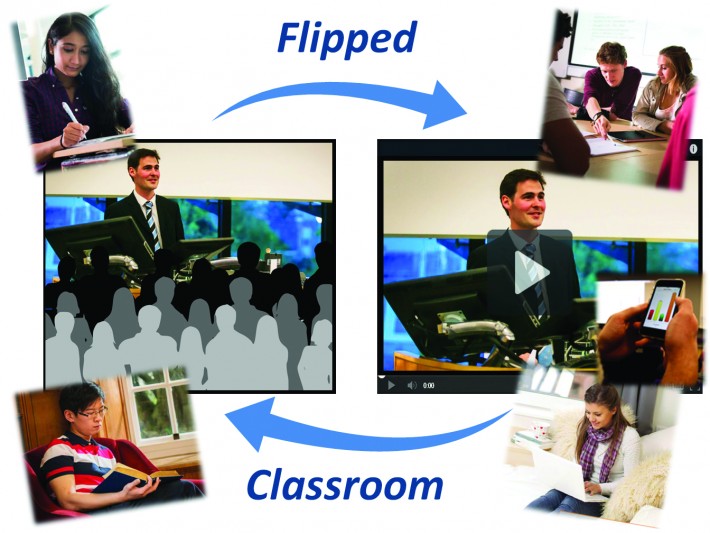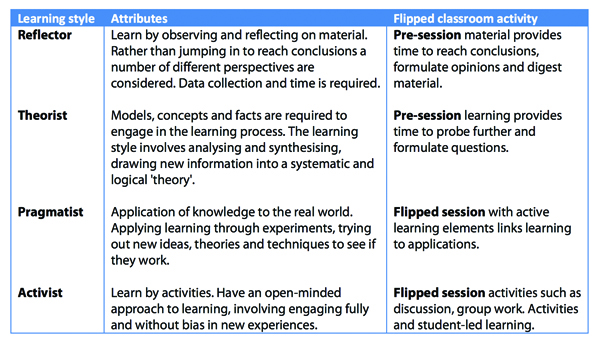by Dr Damien Mansell
This article first appeared in ViewFinder 103
In Moore and Kearsley’s book Distance Education: A Systems View of Online Learning (1996) they state, ‘if there is any one secret to good teaching, it is summed up in the word activity.’ In higher education this is no longer a secret. Active or engaged-learning is a much discussed theme in current education conferences and literature, and in my ‘lectures’ at the University of Exeter I have been using an approach called flipped learning in order to increase active learning. As well as creating a fun and engaging learning environment, I have found that it has a number of additional advantages as well as some challenges.
Flipped learning (or flipped classroom teaching) involves swapping the contact time from the traditional lecture followed by reading or group work to using the contact time for discussion and feedback. The contact time is an interactive, engaging and two-way learning experience, rather than passive learning in the traditional model. Content is delivered through reading in advance, or watching a video, allowing the lecture time to be used to develop understanding through discussion and questions.

It is the way the contact time is used which is the largest benefit for the flipped classroom. Students use the time to construct knowledge and develop understanding rather than simply acquire knowledge. Knowledge construction means students develop understanding through feedback and an opportunity to ask questions. The replaced lecture can take a variety of formats such as a debate, further research, group work, question and answer session, test or sharing of work for peer assessment.
I have learnt while engaging students with this teaching model that they all respond differently to learning styles for processing, absorbing and retaining content. It is important for educators to vary learning styles to avoid disadvantaging learners with particular learning preferences. One way of doing this is by delivering content through online videos, giving the student control over the time, place, and pace of their learning. Being able to pause, rewind, re-watch and re-visit is not just good for students with learning difficulties but is popular with students and is a useful revision resource. Table 1 shows the Honey and Mumford (1982) learning style definitions. I have used these to explain how the flipped approach caters to multiple styles.

Table 1. Adapted summary of the Honey and Mumford learning styles.
Preparation work involving online videos and reading is favourable to the reflector and theorist. Time is available for students to digest material and develop questions which can be asked in the class. The flipped session develops student understanding by applying knowledge, through tasks or activities such as peer evaluation or group work, favouring the pragmatist and activist learning styles.
In its simplest form the flipped classroom is nothing new. Traditional tutorials are just like a flipped classroom. Preparation work is set in the form of reading and the tutorial session is fuelled by discussion and opportunity for students to ask questions. However in the traditional model the tutorials are small groups of students, perhaps six to twelve, chaired by an academic. The flipped classroom approach is now being applied to entire module cohorts. So what has caused this change?
The influence of the flipped classroom on the learning environment has been fuelled by increasing accessibility to educational technology and a growing emphasis of blended-learning in higher education. Blended-learning is when students learn in part through online delivery of content and in part through contact-time sessions. Examples of influencing technology are the success of educational platforms such as Khan Academy and Massive Open Online Courses (MOOC’s), as well as free and intuitive video editing and sharing technologies.
Depending upon the learning objective the video I set in the pre-session material may be existing material or I may create new video content. Box of Broadcasts offers access to an large archive of media allowing the educator to create clips and playlists which can be set to the class. Care and caution must be applied to directing students to videos, as media does not go through the peer-review process of academic publishing. Therefore it is the role of the educator to select reliable content. Some content is produced from reputable sources and so can be considered more trustworthy. For example I co-led the University of Exeter’s first MOOC, ‘Climate Change: Challenges and Solutions’. Most MOOC’s contain video content so can be directed to students. For creating video material which is tailored to the course I recommend screen-cast software such as screencast-o-matic.
Flipped learning creates opportunities for active student-led learning through knowledge construction, increased feedback and engagement…
Educational technology is also being used to support the in-class flipped session. Two good examples of software to facilitate and encourage collaborative learning in the classroom are ResponseWare and Padlet. ResponseWare is an audience response system that offers interactivity (in the form of questions) to PowerPoint slides. Students can see how others have voted which can be used to fuel debate and discussion. Padlet allows students to post content, together with anyone from any device. Content can be questions or answers or further material which can be used to lead in-class discussions.
Delivery through online video has advantages to the educator as well as the learner. By hosting videos on platforms such as YouTube or Flipboard, the educator has access to the analytics. Knowing how many views, and when the material has been accessed, is useful for understanding the cohort engagement. The risks of an unengaging session can therefore be reduced by reminding learners to access the material (if uptake is low). The best way to combat lack of uptake is to make clear the shift in responsibilities to the students. The role change from the traditional lecture does not just impact on delivery and learning styles but shifts responsibilities to the student. Making sure this is communicated to the students beforehand is really important and is often referred to as student-led learning.
By setting student-led learning through task-orientated learning or guided-learning this reduces preparation time required for the flipped session. Pre-session material should match tasks to learning objectives suited for collaboration and discussion. Tasks are the focus of the feedback and engagement-driven session resulting in an active discussion. No further preparation is required other than expertise in the subject area and content in order to chair the session.
In summary a flipped classroom offers new opportunities for active, student-led learning through knowledge construction, increased feedback and increased engagement. Advances in educational technology have fuelled the adoption of this teaching technique to large courses, which caters, for different learning styles and is popular with students. By ensuring the shift of responsibility is communicated to the students, and having the ability to monitor engagement in the online material, the challenges and risks are reduced.
About the Author:
Dr Damien Mansell, Senior Lecturer in Physical Geography at The University of Exeter, obtained his undergraduate degree in Geography B.Sc. at the University of Sheffield (2004-2007). He went on to research for a PhD at Swansea University entitled ‘Controls on the calving rate of North-West Svalbard glaciers’. After his PhD, Damien gained field experience by assisting on a research project in South East Greenland with the GLIMPSE Swansea University Glaciology Group. Damien moved to The University of Exeter in 2011 and is now Senior lecturer in Geography and Programme Director of Physcial Geography. Damien completed postgraduate certificate in Academic Practice in 2013 and achieved the status of Fellow of The Higher Education Academy.